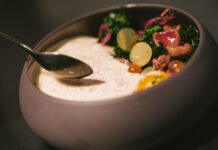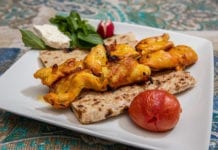You can get outstanding drinks at the bar in the new lounge of the Palace Cafe, but even if you’re not a drinker it’s worth a trip to admire the sleek, spare design. It’s spacious and modern, with rough slate walls accented by wood and metal trim. Step around the corner into the newly redesigned dining area, and the walls are slate and weathered wood planks, the banquettes are soft gleaming leather, and the huge wall hangings are flowering trees painted in Qing Dynasty Chinese style. The dominant – in fact, the only – color is gray, the pearly radiant gray of a Seattle dawn.
“I wanted to capture the look of my favorite restaurants in Seattle,” says chef and owner James Shrader, “where you can walk in wearing a lumber jacket and jeans.”
Amidst this austere yet elegant setting, though, you’d also feel comfortable in your finest suit and tie.
Natural, earthy materials and simple elegance influenced by Seattle, China and the whole Pacific Rim: what’s true of the decor is also true of Shrader’s cooking and perhaps Shrader himself. Fascinated by food as far back as he can remember, he tried to invent new ways of cooking simple dishes while still in grade school. He’s still doing that, obsessed with perfecting dishes that are lackluster everywhere else.
“Being creative isn’t the most important thing,” Shrader says. “It’s doing the dish well.”
Shrader graduated from what many consider America’s finest cooking school, the Culinary Institute of America. But most of what he’s learned comes from observing the world around him: The fascinating panoply of the farmers’ markets in Seattle and, later, of the big Saturday market right outside Palace Café’s door. He learned to base his dishes on fresh and local ingredients long before that became the fashion. Shrader used to call his cooking style “nouveau American cuisine,” but now he favors the phrase Pacific Rim. Indeed, a subtle Asian influence infuses many of his finest entrees. Braised beef short ribs, his take on a classic Yankee pot roast, are simmered in a veal gastrique accented by a blend of caramelized sugar and vinegar often used in China. He makes Moroccan-style preserved lemons to use in several of his dishes because, though North African, they blend sour and salty flavors in a way favored by Chinese cooks. Slow-roasted duck features a blend of Chinese spices, all freshly ground in house, including star anise, toasted cloves and Sichuan peppercorns.
East Asian flair and presentation are most clearly evident in the unique Bento section of the menu. These are tiny, bite-size appetizer plates prepared with haiku-like precision. Miniature filets with sauteed onions, salmon cakes with braised fennel and chicken-fried chicken with tomato chutney are each made with the care normally devoted to full-sized entrees. They can be ordered individually or in a set of six. A separate vegetarian menu, complete with bentos, appetizers and a full selection of entrees, is enticing enough to convert a carnivore. One entree features a grilled apple-sage polenta cake topped with layers of goat cheese, wilted spinach and cherry chutney. Another is wild mushroom ravioli.
The vegetarian menu is available only at dinner. But there’s also a full lunch menu, consisting of less elaborate, modestly priced selections, and also Sunday brunch. Shrader has maintained the same high standards as when Palace opened in 2003, and it is this as much as the breathtaking new decor that makes his restaurant cutting-edge, trendy and, like his produce, forever fresh. 1301 E. 15th St., Tulsa. www.palacetulsa.com


























